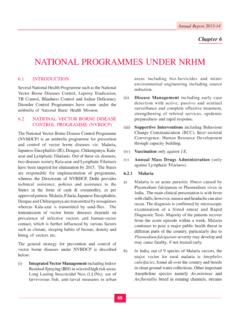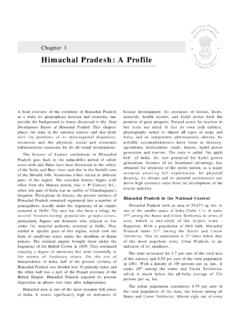Transcription of Information on Natural Disasters Part- I Introduction
1 Information on Natural Disasters part - I Introducti on Astrology is the one that gave us the word disaster . Many believe that when the stars and planets are in malevolent position in our natal charts bad events or bad things would happen. Everyone one of us loves to avoid such bad things or Disasters . The disaster is the impact of both Natural and man-made events that influence our life and environment that surrounds us. Now as a general concept in academic circles, the disaster is a consequence of vulnerability and risk. The time often demands for appropriate reaction to face vulnerability and risk. The vulnerability is more in densely populated areas where if, a bad event strikes leads to greater damage, loss of life and is called as disaster .
2 In other sparely populated area the bad event may only be a risk or hazard. Developing countries suffer the greatest costs when a disaster hits more than 95 percent of all deaths caused by Disasters occur in developing countries, and losses due to Natural Disasters are 20 times greater as a percentage of GDP in developing countries than in industrialized countries. A disaster can leads to financial, environmental, or human losses. The resulting loss depends on the capacity of the population to support or resist the disaster . The term Natural has consequently been disputed because the events simply are not hazards or Disasters without human involvement.
3 Types of disaster s Any disaster can be classified either as Natural or man-made . The most common Natural Disasters that are known to the man kind are hailstorms, thunderstorm, very heavy snowfall, very heavy rainfalls, squalls, gale force winds, cyclones, heat and cold waves, earthquakes, volcanic eruptions, floods, and droughts which cause loss to property and life. The human induced or man-made Disasters are war, accidents. Some of the Disasters can be associated with human activities such as industrialization, deforestation, urbanization which invariably produce air pollution, water pollution those in turn cause global warming, climate change, depletion of glaciers, depletion of ozone layer, increase in ultraviolet radiation, avalanches, flash floods and water-logging in low lying areas.
4 Status of disaster management in India The Ministry of Agriculture, Government of India has set up a High Powered Committee functioning under the Prime Minister of India to review disaster management machinery in the country and to formulate a comprehensive model plan for disaster management at the National, State and District levels. This committee was constituted under the chairmanship of Shri , former secretary to Government of India with 11 members including Director General of Meteorology, India Meteorological Department as one of the members. The HPC has framed five sub-groups for disaster management Plan wherein the responsibility of India Meteorological Department lies in identification of weather and climate related hazards and Disasters .
5 The basic components of the comprehensive programme would be Prevention, Mitigation and Preparedness the awake of any likely disaster . Natural Disasters of importance and relevance The decade 1990-1999 was declared as the International Decade For Natural disaster Reduction (IDNDR). Government of India declared the current decade as the "National Decade for disaster Reduction" (NDDR). Nearly 80% of Disasters effect humans. Between 1988-1997 50,000 lives lost and caused 60 billon dollars economic loss. Latest World disaster report, 2003 suggests increase in weather related Disasters . Average 200 Disasters per year during 1993-1997 increased to 331 per year during 1998-2002.
6 Earthquakes The most important and most disastrous Natural event that considerably effects the human population and their property is Earthquake . The earthquakes strike without any forewarning and cause enormous damage to the human dwellings, roads and bridges, dams and culverts and also take millions of lives and affect millions more. The earthquakes are now known to be caused either by relative motion of rocks within the earth s crust or due to tectonic plate collisions. When an Earthquake occurs, waves of elastic compression spread out through solid earth similar to the waves that spread across a pond. When these waves arrive at the surface they shake it violently near the source of the Earthquake and mildly at distant points.
7 The ground shaking is responsible for all the damage. During the Earthquakes most of the damage is due to horizontal motion and vertical motion can be felt only at the epicenter. The earthquake magnitude is generally indicated on scale called Ritcher scale . Worldwide about 18 earthquakes magnitude (M) or larger occurs every year. Actual annual numbers since 1968 range from lows of 6-7 events/year in 1986 and 1990 to highs of 20-23 events/year in 1970, 1971 and 1992. As the earthquakes are not frequent and data on earthquakes is very sparse. The stress build up in the rocks need to be monitored and as such warnings to be issued within a short time. The warnings may often turn in to a hoax due to the complicity of the problem.
8 Creating awareness, delineation of the earthquake disaster prone areas can help in mitigation of the disaster . India has been categorized into different seismic zones depending on the susceptibility to earthquake. Landslides Earth s surface is curved into different landforms such as mountains, hills, valleys etc. Every mountain or hill has its own slope stability. Gravity is the main factor for the landslides even though a trigger is a must before any landslide can occur. The landslide is a geological phenomenon where rock debris, mud falls from the slopes under the influence of the trigger and gravity. The landslides can be categorized as shallow landslides, deep-seated landslides, earth flows, mudflows etc.
9 It seen that the landslides can occur due to Natural causes like erosion due to flow of rivers and glaciers, saturated soil to persistent rains, heavy rainfalls, earthquakes and volcanic eruptions. The landslides are also caused by manmade activity such as blasting or heavy machinery traffic or vibration. In India, Arunachal pradesh , Sikkim, West Bengal and Himachal pradesh are prone to landslides. Areas that are generally prone to landslide hazar ds a. Existing old landslides. b. Base of slopes. c. Base of minor drainage hollows. d. Base or top of an old fill slope. e. Base or top of a steep cut slope. f. Developed hillsides where leach field septic systems are used. Areas that are typically considered safe from landslides a.
10 Hard, non-jointed bedrock that has not moved in the past. b. Relatively flat-lying areas away from sudden changes in slope angle. c. Top or along the nose of ridges, set back from the tops of slopes. Forest Fires Forests worldwide are prone to Disasters like forest fires. The forest fires destroy valuable forest wealth, creates imbalance in the bio-diversity and ecosystem by destroying the various species of flora and fauna. The forest fires do often occur during summer months during which the forest floor is covered with lots of dry leaves and twinges which become ignited due to various Natural and man made causes. The Natural causes of forest fires are intense heat, lightening, higher wind speeds.









